Reviews
Mister FPGA Review: An In-Depth Look at the Ultimate Retro Gaming Solution

As someone who’s deeply passionate about retro gaming, I’ve explored almost every avenue to preserve and relive the magic of classic games. From playing original consoles to using software-based emulators, I’ve tried it all. However, when I stumbled upon the Mister FPGA, I realized this might just be the ultimate device for retro gaming aficionados. In this Mister FPGA review, I’ll share my hands-on experience, provide insights into its functionality, and explore why it stands out as one of the most authentic retro gaming experiences on the market today.
What is the Mister FPGA?
To begin with, it’s essential to understand exactly what the Mister FPGA is and how it differs from other retro gaming solutions. The Mister FPGA is an open-source platform designed to replicate the hardware of vintage video game consoles and computers using Field-Programmable Gate Array (FPGA) technology. Unlike traditional emulators, which rely on software to mimic old hardware, FPGA devices like the Mister replicate the original circuits of these systems, providing a much more accurate and faithful gaming experience.
In simpler terms, rather than trying to simulate the old gaming hardware, the Mister FPGA rebuilds it on a chip. This means that the games you play on the Mister FPGA run in a way that’s almost identical to how they ran on the original systems. The device is versatile, supporting a wide array of consoles, from the iconic NES, SNES, and Sega Genesis to more obscure systems like the Neo Geo and Commodore 64.
What sets the Mister apart from other retro gaming solutions is its ability to emulate a vast number of platforms with remarkable accuracy. It’s a truly open-ended device that supports countless cores—software modules that emulate specific consoles or computers—and provides the flexibility to swap between them easily. This makes it perfect for anyone who wants to relive the glory days of classic gaming or explore systems they may have missed out on in their youth.
The Setup Process: A Steeper Learning Curve
When I first set up the Mister FPGA, I was prepared for a more hands-on experience than I was used to with other retro gaming systems. While devices like the Raspberry Pi or retro consoles with pre-loaded games are plug-and-play, the Mister FPGA requires a bit more effort to get up and running.
Setting up the Mister FPGA involves a few key steps: first, you need to load the necessary software onto an SD card, download the cores for the systems you wish to emulate, and then configure the device’s settings to your liking. While the setup process isn’t overly difficult, it’s certainly more involved than other, more consumer-friendly solutions. However, for anyone with a bit of technical knowledge or a willingness to learn, this process isn’t too challenging. Plus, there’s a wealth of online resources and a dedicated community ready to assist with any troubleshooting.
Once the initial setup is complete, you’ll quickly notice that the Mister FPGA offers a wide variety of customization options. You can tweak video settings like resolution and refresh rate, adjust the input methods for your controllers, and even set up custom configurations for specific cores. While these options may seem overwhelming at first, they ultimately allow you to fine-tune the experience to your exact preferences.
Performance: The True Test of Authenticity
Now, let’s get to the heart of this Mister FPGA review: performance. After everything was set up, I loaded up a few of my favorite retro games to test the system. From the very first game I played, it was clear that the Mister FPGA wasn’t just another emulator—it was something special.
I started with Super Mario Bros. on the NES. Right off the bat, the visuals were sharp, and the controls felt incredibly responsive. There was no noticeable input lag, which can sometimes be an issue with software emulation. The sound was crisp, and the gameplay experience felt identical to playing on the original NES hardware. As someone who’s spent a lot of time playing retro games, I immediately noticed the difference between the Mister FPGA’s performance and what I’d seen on software-based systems.
Next, I tried a few arcade classics like Pac-Man and Street Fighter II. These games, which are known for their precise timing and fast-paced action, ran flawlessly on the Mister FPGA. The image quality was vibrant, the sound was spot-on, and the gameplay was smooth. It felt like I was playing on the original arcade cabinets, complete with the familiar controller inputs and graphical fidelity.
I also tested out more demanding systems like the Sega Genesis and Super Nintendo. The Mister FPGA continued to impress, handling the more complex graphics and sound of games like Sonic the Hedgehog and The Legend of Zelda: A Link to the Past without a hitch. Whether I was exploring Hyrule or speeding through the Green Hill Zone, everything ran smoothly, and the overall experience was just as I remembered it.
Customization: A Feature That Stands Out
What makes the Mister FPGA truly remarkable is the level of customization it offers. Unlike other retro gaming devices that are limited to a set number of games or systems, the Mister FPGA allows you to add or remove cores based on your preferences. This means that if you want to emulate the original Atari 2600 or try out the Neo Geo’s legendary library of fighting games, you can do so with just a few clicks.
The device also supports a range of display options, including HDMI output for modern TVs and monitors. For those who want to get even closer to the authentic experience, the Mister FPGA also supports CRT displays, which many retro gaming enthusiasts swear by. You can adjust settings such as resolution, refresh rate, and scaling to suit your preferences and ensure that your games look as good as possible.
Additionally, the Mister FPGA has a dedicated community of developers and users who are constantly working on new features and updates. Over time, more cores are developed, and bugs are fixed, ensuring that the system remains relevant and continues to offer excellent performance for years to come.
Comparing Mister FPGA to Traditional Emulators
It’s important to compare the Mister FPGA to traditional software-based emulators, as this is where it truly shines. Emulators like RetroArch are fantastic for casual gaming and provide a way to play retro games on modern devices. However, they can’t match the precision and authenticity of FPGA-based hardware.
When using traditional emulators, there’s often a noticeable difference in how games play. Software-based systems can suffer from input lag, graphical glitches, or sound issues that break the immersion. The Mister FPGA, on the other hand, doesn’t rely on software to simulate hardware. Instead, it recreates the original systems’ circuits, delivering an experience that’s as close to the real thing as possible.
Additionally, the flexibility of the Mister FPGA is unmatched. While traditional emulators might support a handful of systems, the Mister FPGA can emulate a massive variety of platforms, from old home consoles to arcade machines and computers. If you’re someone who wants to experience the full breadth of retro gaming, the Mister FPGA is a far superior option.
Conclusion
After spending considerable time with the Mister FPGA, I can confidently say that it’s an absolute must-have for serious retro gamers. The authenticity, performance, and customization options make it stand out from other devices on the market. While the setup process might not be as straightforward as some other retro gaming solutions, the effort is well worth it for the incredible gaming experience you’ll get in return.
In this Mister FPGA review, I’ve explored the device’s key features, its performance, and the overall user experience. Whether you’re a seasoned retro gamer or someone looking to explore the classics, the Mister FPGA offers an unmatched level of quality and versatility that other devices simply can’t compete with. If you’re looking for the best way to experience your favorite retro games, the Mister FPGA is definitely worth considering.










